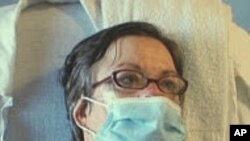<!-- IMAGE -->
Some hospital emergency rooms in the United States are facing severe strains dealing with the H1N1 flu outbreak, while others are handling cases without much difficulty. One small hospital outside of Washington began planning last April for an influx of flu patients.
Infectious disease physician Tam Ly says she is seeing fewer and fewer suspected cases of the H1N1 virus here at Fauquier Hospital, south of Washington. Dr. Ly says the first wave of infections at her hospital peaked in late October. She is expecting another wave to start within the next few months.
<!-- IMAGE -->
"Our hospital was prepared because we had a plan in place for months prior in anticipation that this might occur," she noted. "We always hope for the best but we always anticipate and prepare for the worst."
Rural Fauquier County Virginia is known for its rolling hills, and horse farms. Fauquier Health is a small 100 bed hospital that serves the community of Warrenton.
When the first cases of the H1N1 virus were reported in Mexico last April, Fauquier Hospital began planning. Tracy Turman is in charge of emergency preparedness for the hospital.
"We knew that there was a potential for this to really snowball and our planning basically began at that point to adapt our existing pandemic flu plan to meet the needs of the H1N1," Mr. Turman explained. "We've got the regular emergency room section and then we have converted this entry point into a flu clinic. We have taken this little vending area and turned it into a waiting room."
Hospital officials divided Fauquier's emergency room into two separate areas with a designated entrance and triage area for flu patients.
Their goal is to handle any surge of patients while keeping the virus from spreading to other parts of the hospital. There are special air scrubbers throughout the clinic that remove infectious materials from the air. The treatment rooms have specially designed ventilation systems that recycle room air 12 times in an hour. All staff wear masks and gloves when entering a treatment room.
Their planning paid off when flu cases surged in the Emergency Department. Turman says having a separate flu clinic meant less stress on staff and facilities.
"We normally see about 80 patients a day," he said. "That is our average in the Emergency Department. There was one day about ten days ago when we actually saw 158 patients. 50 of those patients had flu like symptoms."
Most of the flu cases at Fauquier Hospital have been people in the high risk groups: pregnant women, young children and people with weakened immune systems. If flu cases should surge again, hospital officials say they are confident they are ready to respond. And as more and more people in the Warrenton area receive the H1N1 vaccine, hospital officials are hoping the worst is over.







